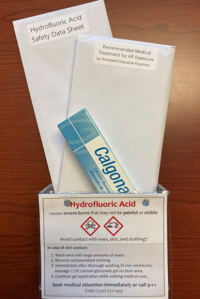Hydrofluoric Acid Producing Compounds
Hydrofluoric acid (HF) is a hazardous chemical that can readily penetrate the skin, leading to the destruction of soft tissues and decalcification of bones. Poisoning can occur through minimal exposure of skin, eyes, inhalation, or ingestion. Acute effects of exposure to concentrated (>5%) HF include severe pain, respiratory irritation, severe eye damage, and pulmonary edema. Exposure to less concentrated solutions may have equally serious but delayed effects. A splash of HF to more than 25% of the body can be fatal.
One chemical group that is often overlooked are HF-producing materials/compounds. These materials/compounds produce HF upon contact with water and requires immediate first aid, in the same way as HF itself.
How to identify HF-producing materials/compounds
The Chemical Hygiene team has developed a custom chemical band in RSS Chemicals to help labs identify chemicals that may fall into this hazard category. Follow the tutorial to utilize this custom chemical band.
This is not a comprehensive list of HF-producing materials/compounds! The chemicals included in the custom chemical band are the most common chemicals found in laboratories: your lab may have additional materials that produce HF and need to have the appropriate training and first aid materials on hand. HF-producing materials/compounds can be identified in the safety data sheet in Section 2.3: Hazards not otherwise classified:

HF-producing materials/compounds are also identifiable by their first aid procedures listed in Section 4.1: Description of first-aid measures. The first aid measures for HF-producing materials/compounds are the same as for HF itself.
Requirements for HF-producing materials/compounds
Labs using or storing HF-producing materials must have a standard operating procedure (SOP) that describes the specific hazard of the material/compound. This SOP could either be a chemical specific SOP, developed using the SOP Template, or labs can use the HF SOP and modify to describe the specific material located in the lab. Labs possessing these materials must have calcium gluconate on hand.

FREE Mini Emergency Kit for HF-producing materials/compounds
Contact chem-safety@ucdavis.edu if you have identified that your lab has HF-producing materials/compounds for a free mini emergency kits. The kits contain helpful information for HF exposure in a handy magnetic bin with emergency information on the front so that the kit can be placed where HF-producing materials/compounds are being handled.
NOTE: Labs are responsible to provide the calcium gluconate for the mini emergency kits for HF-producing materials/compounds. A list of vendors is included with the kit and can also be found in SafetyNet 70.
SafetyNet 70
SafetyNet 70: Safe Use of Hydrofluoric Acid has been updated and now includes information on HF-producing materials.